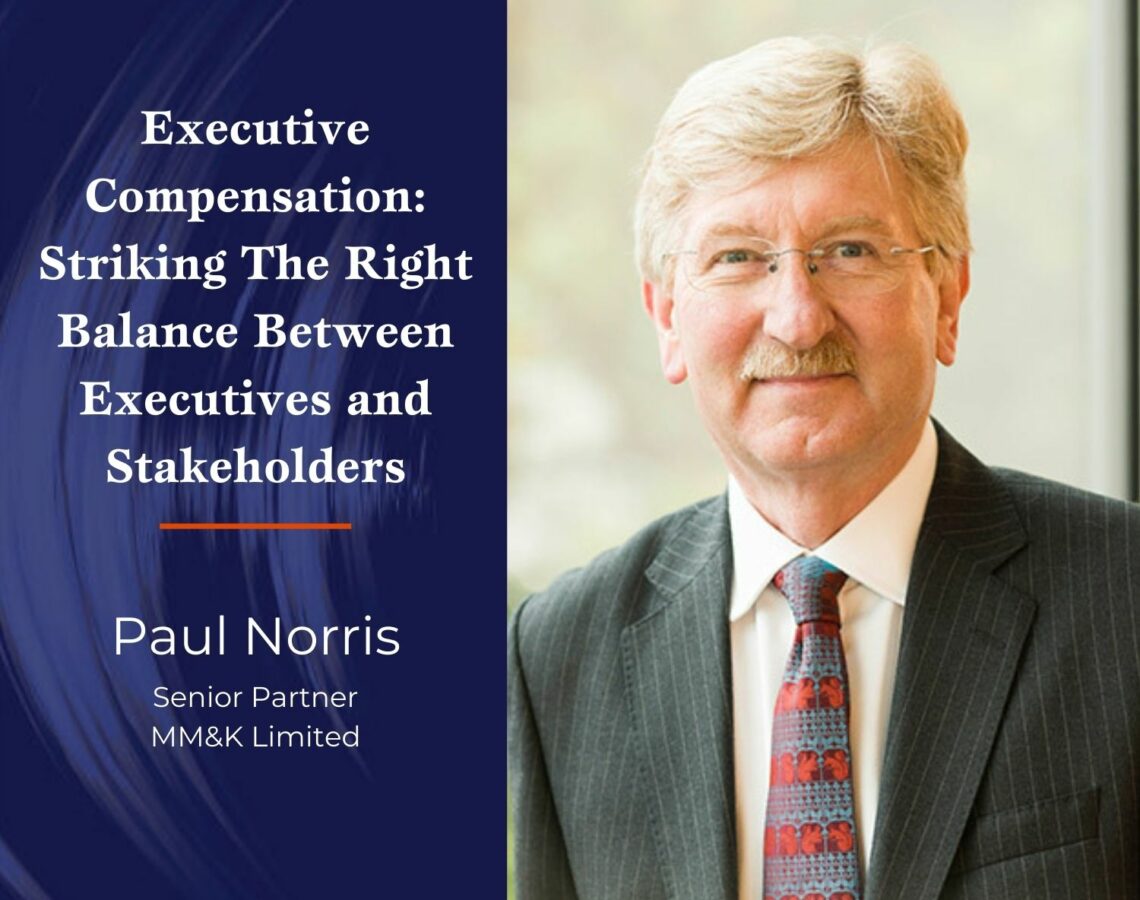Executive Compensation: Striking The Right Balance Between Executives and Stakeholders

Executive pay attracts attention and scrutiny as companies and society face the challenges of rising prices and interest rates, although the latter might have peaked.
Executive pay attracts attention and scrutiny as companies and society face the challenges of rising prices and interest rates, although the latter might have peaked. At next year’s AGMs, many listed companies will submit their directors’ remuneration policies to a binding shareholder vote in the UK. Executives eye US packages, while shareholders want to see remuneration policies that are fair and linked to the business strategy deliverables. How can companies strike the right balance? What is fair?
In this podcast, Dr Sabine Dembkowski, Founder and Managing Partner of Better Boards, discusses executive compensation with Paul Norris, Senior Partner of MM&K Limited, with over 35 years’ experience in executive compensation and advising on remuneration structures, policy, performance, and governance. He has developed remuneration strategies and incentive plans for companies facing major business or human resources challenges (a new growth phase, IPO, turn-around, transformation or company sale, etc.) and is an expert in the design and implementation of executive remuneration policies and incentives linked to business plan goals. A member of the QCA’s Corporate Governance Experts Group and experienced in negotiating bespoke executive remuneration packages with founders and investors, he has a Master’s degree in Law and is a qualified barrister.
Some of the key takeaways of the conversation include:
“There’s no doubt the role of remuneration committees and remuneration committee chairs has become more demanding”
Paul sees remuneration committees (RemCos) facing more demanding and more complex challenges than in the past. Why? It comes down to four key challenges.
First, there’s a much broader range of interests and objectives from a larger group of stakeholders to manage than ever before. Second, RemCos must pay attention to official regulatory groups and unregulated proxy agents nationally and internationally. Third, management succession planning is becoming more important. Paul sees a lot of scope and a good argument for mixing and blending the work of the nomination and remuneration committees. He feels this collaboration can bolster diversity and inclusion at the board and executive levels. Fourth, there’s the challenge of solving the pay-for-performance equation. Given high levels of investor support for the remuneration policies of the largest UK and Canadian companies, Paul feels it is quite possible. He sees no reason why remuneration committees globally can’t also reach high remuneration acceptance rates.
“What works well is being visible”
With so many stakeholders and interested parties to satisfy, Paul says the role of the remuneration committee is expanding. To fulfil that role successfully, he feels communication is key.
First, good communication between the committee, HR, and the CEO is essential. This is the basis of a good working relationship and a successful remuneration policy. It also helps with building support from internal stakeholders.
Then there’s the matter of the broader stakeholders from within and outside the company. Here, Paul feels the most important thing is to be visible with the work being done, the goals of that work, and the outcomes that have been achieved. He says many companies talk about what they’d like to do or their aspirations. Still, few companies are telling a clear story of how they are using remuneration packages to drive diversity, fair pay, ESG targets, or their strategic vision.
To help this story come across, Paul notes that reporting needs to be done in a standard form that everyone can understand. Shareholders and outside parties – as well as internal staff – should be able to tell the company story and quickly find answers to key questions around fair pay, incentives for performance, links between pay and ESG targets, as well as information about how company pay practices align with regulatory rules and international best practices.
“Don’t report what you’d like to do. Report what you have done”
Paul says what shareholders are looking for is clear reporting of actual results. Being able to see this and see progress drives shareholder engagement and sentiment around the company and board effectiveness. Clear disclosure also opens the door for feedback from stakeholders, shareholders, and regulators, both in the public sphere and internally. Getting this feedback is vital for effective governance and compliance, too.
“There’s a much, much greater use of ESG performance targets and executive incentives”
Paul’s firm does a lot of research into ESG as it relates to company performance and remuneration. One trend he sees globally is linking ESG targets with executive incentives on a much broader scale than before – he estimates as many as 80% of the world’s largest firms are doing this. It’s not just a trend in the regulation, though that’s a part of it, but there’s also great pressure from investors to link ESG targets with executive pay.
This is another place where controlling the company story and crafting a consistent narrative is key. You want to tell a story both stakeholders and regulators can understand and be able to match your story to demonstrate progress against targets. Paul also says that he’s seeing a shift – there was a heavy emphasis on ESG targets in short-term incentives, but ESG targets in long-term incentives are now becoming more prevalent.
Paul feels one driver of this shift is that it has been difficult to accurately measure certain elements of ESG. It’s one thing to look at a management structure and measure the diversity there, but it’s much more difficult to measure emissions levels across a complex global supply chain. Larger companies, with more resources, are beginning to get to grips with the effects their businesses have on ESG factors. But everything really needs to align with the overall business strategy and goals. It’s a complex process but an exciting challenge.
“The money’s got to come from somewhere”
Paul says there has to be a balance between financial and non-financial performance targets in incentive plans. He feels that there will continue to be a rising use of blended performance scorecards, where most incentive payments will be based on financial performance measures, and the balance will be made up of strategic and perhaps ESG measures. This ensures that companies can continue to thrive financially, as the money for pay packages must come from somewhere!
Paul also sees a trend toward longer performance measurement periods. In many industries, a one-year or three-year timeframe isn’t long enough to fully measure performance shifts, as it doesn’t align with the company’s investment and return cycles. Couple that with pressure from UK regulators to extend timeframes, and Paul says you’re seeing companies adopt five or even seven-year incentives. It’s complex, but Paul says committees that can set up careful parameters and do a good job telling their story will ultimately be in a much better place to deal with that challenge than those who have not.
The three top takeaways from our conversation are:
- Don’t be afraid to ask the right questions. They may be difficult questions, and that’s the point.
- Get on the front foot and tell the story! Engage with stakeholders and shareholders.
- Ensure there is a robust corporate governance framework to which both executives and non-executives have fully bought in.
Don’t forget to subscribe never to miss an episode of the Better Boards Podcast Series. Available on Apple, Spotify or Google.
To find out how you can participate in the Better Boards Podcast Series or more information on Better Boards’ solutions, please email us at info@better-boards.com.



